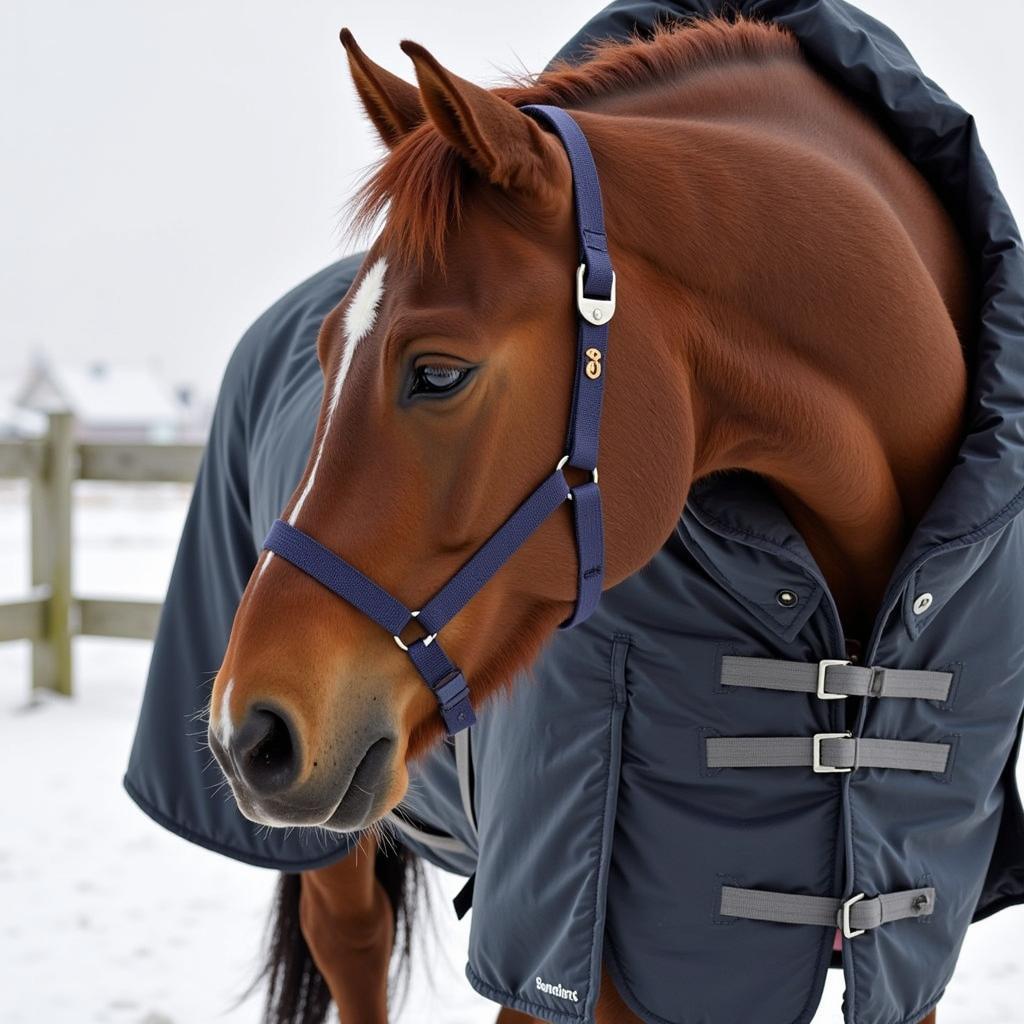A Surcingle For Horses is a vital piece of equipment for riders of all disciplines. This versatile piece of tack serves multiple purposes, from keeping blankets in place to aiding in training. Whether you’re a seasoned equestrian or a new horse owner, understanding the uses, benefits, and types of surcingles is essential.
What is a Horse Surcingle?
 Horse Wearing a Surcingle
Horse Wearing a Surcingle
A surcingle is essentially a wide strap that fastens around a horse’s girth area. While often used in conjunction with other horse training equipment, it can also be used independently for specific training purposes.
Why Use a Surcingle on Your Horse?
Surcingles offer a range of benefits, making them a valuable addition to your tack room. Here are some key reasons why you might use a surcingle:
- Securing Horse Blankets: Perhaps the most common use for a surcingle is to keep horse blankets from slipping. By providing extra security, surcingles ensure your horse stays warm and dry, especially during harsh weather conditions.
- Training Aid: Certain types of surcingles, like training surcingles, feature rings and attachments designed to help with groundwork and lunging exercises. These attachments allow you to control your horse’s movement and encourage proper form.
- Rehabilitation and Support: For horses recovering from injuries or with specific muscle weaknesses, a surcingle can offer additional support and stability. This is particularly useful when reintroducing a horse to work after a period of rest.
Types of Surcingles for Horses
With various types of surcingles available, selecting the right one depends on its intended purpose. Here are the most common types:
- Standard Surcingle: This basic type is typically made from strong webbing or leather and features simple buckles for fastening. Its primary function is to secure horse blankets.
- Training Surcingle: Equipped with multiple rings, loops, and straps, these surcingles allow for versatile training applications. They are designed to help improve a horse’s balance, strength, and flexibility during groundwork.
- Stud Girth: Often used on stallions or horses prone to kicking, a stud girth is a protective surcingle that helps prevent injury during breeding or handling.
 Different Types of Horse Surcingles
Different Types of Horse Surcingles
Choosing the Right Surcingle
When choosing a surcingle, consider the following factors:
- Purpose: Determine the primary reason for using a surcingle, whether it’s for blanket security, training, or rehabilitation.
- Material: Surcingles are typically made from leather, nylon webbing, or synthetic materials. Each material offers varying levels of durability, comfort, and ease of cleaning.
- Fit: A properly fitting surcingle is crucial for your horse’s comfort and safety. Ensure the surcingle lies flat against the horse’s body without pinching or restricting movement.
- Features: Depending on the intended purpose, consider features like adjustable straps, ring placements, and padding for added comfort and functionality.
Proper Surcingle Use
While surcingles are valuable tools, using them correctly is paramount to your horse’s well-being. Always remember:
- Never use a surcingle on a horse that is not fully grown.
- Ensure the surcingle is fitted correctly and doesn’t cause any discomfort or rubbing.
- Regularly check the surcingle for signs of wear and tear and replace it when necessary.
Caring for Your Horse’s Surcingle
Proper care extends the life of your surcingle and maintains its quality. Follow these care tips:
- Clean the surcingle regularly to remove dirt, sweat, and grime.
- Use a mild soap and water solution for cleaning, avoiding harsh chemicals.
- Allow the surcingle to air dry completely before storing it in a cool, dry place.
FAQs About Surcingles for Horses
What is the difference between a surcingle and a girth?
While both encircle the horse’s girth area, a girth is used primarily for saddle attachment, while a surcingle serves other purposes like blanket security and training.
Can I leave a surcingle on my horse overnight?
It’s generally not recommended to leave a surcingle on your horse overnight as it can cause discomfort and restrict movement.
How tight should a surcingle be?
A surcingle should be snug but not too tight. You should be able to comfortably fit two fingers between the surcingle and your horse’s body.
What is a crupper surcingle?
A crupper surcingle is a type of training surcingle that includes a crupper strap, which passes under the horse’s tail to prevent the surcingle from slipping forward.
Where can I find a high-quality horse surcingle?
For a wide selection of durable and well-made surcingles, explore the range available at Justus Horses USA. We offer a variety of surcingle styles to suit your horse’s needs.
Conclusion
A surcingle is a versatile piece of equipment that no horse owner should be without. From securing blankets to aiding in training, understanding the different types and uses of surcingles ensures you choose the right one for your equine partner. By following these guidelines and providing proper care, your surcingle will provide years of reliable service.
Need help finding the perfect surcingle or have other horse-related questions? Contact us at Phone Number: 0772127271, Email: [email protected] Or visit us at QGM2+WX2, Vị Trung, Vị Thuỷ, Hậu Giang, Việt Nam. Our dedicated customer support team is available 24/7 to assist you. We also have other resources such as information on horse turnout sheets and the best horse blanket for winter. For those interested in blankets, you can find winter horse blankets on sale and explore different blanket horse designs. Lastly, be sure to check out our horse training equipment.